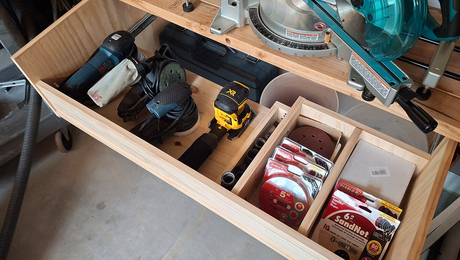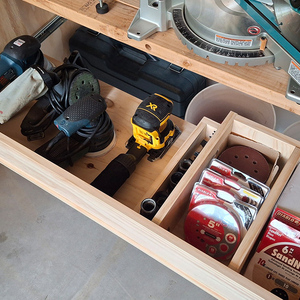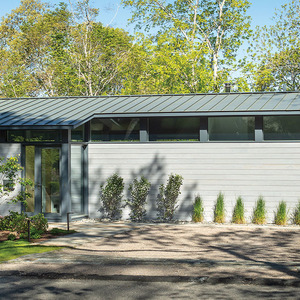I have been asked by a client to design and construct a stairway within their two car garage to enable access to the bedroom above. They would like to be able to rent the space out at some point in the future and provide direct access to the space without the need to pass thru the main house. The bedroom currently exists and has been used for many years as an additional living space within the house. My plan, at least at this point, is to cut an opening in the floor / ceiling at the far end of the garage and build an enclosed stairway to the bedroom above.
Can anyone point me in the right direction to learn about the proper way to design a stair access that will isolate the bedroom from auto exhaust fumes and maintain the proper fire barrier?
A few questions….
Are their any standard building practices that apply to maintaining air quality between attached garages and house living spaces? E.g. are two doors, one within the garage and one at the top of the stairs the way to go? etc., etc.
Many thanks!



















Replies
Greetings Mark,
Sounds like it's going to be an exterior stairway.
Does your message mean that an internal stair is not to code? Mark in Montpelier, VT
I'm not the one to inquire with. Tim and Piffin will have more expertise for advice.
There has to be one fire escape . Rex is correct
You want all walls and or the cieling between to be fire rated. The connecting door fire rated. Have an egress window.
Lots of places do not require a fire escape other than egress window. You ar going to want to check local codes.
I have done this twioce and just built the stair up inside with surronding walls and fire door at bottom
Welcome to the
Taunton University of Knowledge FHB Campus at Breaktime.
where ...
Excellence is its own reward!
In my opinion it would be a big mistake in the first place to put stairs inside the garage, we are talking about a building with the strong possibility that carbon monoxide will be in it at one point or the other.So,the best way is eliminate the garage door so no vehicle can enter,and convert the whole garage....
Mark,
Around here you have to do as Piffin said with an enclosed stairway with fire rated sheetrock and a fire rated door. You would also have to pour a 4" slab first with a platform to land the stairs on and then put your door in. Any door that enters a house from a garage has to be on a 4" slab first in New Jersey anyway. Check out you code. The one I did last year only had the one door at the bottom where the slab was. There's millions of house that have fire rated doors going from the garage to the inside of the house but the garage floor is always 4" lower. Some houses the garage floor can be 2' 3' or 4' lower so we build stairs going to a platform but you still have a fire rated door.
Joe Carola
Edited 12/11/2004 5:38 pm ET by Framer
What's the reasomn for the 4" step there? I am assuming to keep heavy CO down from leaking in.
If that is the case, and CO would stay at the bottom and not ascend the stairs to the living space there.But maybe uit has to do with gas vapours or something else.We automaticaly put ALL entry doors everywhere with at least a 4" step for ice and weather so this catches me unawares.
Welcome to the Taunton University of Knowledge FHB Campus at Breaktime. where ... Excellence is its own reward!
The 4" step is actually termed a "gas curb" and is there to prevent gas leaks (the liquid kind, as in "gasoline") from entering the living space. As for carbon monoxide issues, I checked on that one for a house I just finished. There is a five foot stairwell at the rear of the garage going DOWN to the fire door into the house, so heavy CO could rest in the stairwell. Neither UBC 97 nor the IRC addresses this issue; for these codes, a pool of CO in the stairwell is just fine. I did build in a 6" slope front to rear in the garage floor, so the CO would have to run uphill for 6" before dropping into the well.The High Desert Group LLC
So lets say the person living there wants to warm up the car in the winter and it`s inside the garage so they start it up and go sit on the couch an wait for it to get warmed up while inadvertently carbon monoxide comes up the stairs and the apartment fills up with carbon monoxide which you can`t see or smell but yet it could kill them, if they fall asleep on the couch, who actually as at fault here should an accident like that happen, do they go after the builder, home owner or building inspector where does the buck stop.
I bet the lawyers would take the shotgun approach and sue everyone that had ever stepped foot in the garage/apt.
If the code was followed (mighty big "if" for most homeowners) and the homeowner did not disable the boomer (self-closing) hinges, not a lot (certaintly less than if the man door was open) of CO would make it upstairs.
Went to a confrence once in Anchorage AK where the presentor - Phil Kalloza (sp) had studied garage/living space seperation. He had some pretty ugly comments about what makes it into a typical home even when there is a code complient seperation. He more or less said have a detached garage or nothing.
I will not even bother to address the idiot who leaves a car running in a garage.
True it would take an idiot to do leave a car warming up in a garage but it could also happen to some one that is still half a sleep an on a monday morning and feeling lazy....there are people out there that just don`t know any better Tim
What's the difference between framing a closed in wall and a fire rated door for the stairs as opposed to a wall with a fire rated door going from the garage to the house which you see just about on every house. How come there's no problems with those doors. It's the same thing you have a wall going into the house from the garage with a fire rated door and a wall going to a stairway with a fire rated door. Why would carbon monoxide go into the stairwell and not the house?Joe Carola
only thing i can think of is that the vehicle fumes rise
"only thing i can think of is that the vehicle fumes rise"What about all the house we build that have bedrooms and bathrooms over the garage. We build them all the time with no problems. If fumes rising was a concern then you probably wouldn't have house built with rooms over the garage and there's tons of house built this way.Joe Carola
Well he was talking about building stairs from inside the garage up to the bedroom above, i just did`nt think it was a good idea.... if you guys are ok with it then fine ....The building inspector has the final say on it.
Edited 12/12/2004 9:22 am ET by shavey
The building inspector has the final say on it.
Thank you , I believe I will.
Every building ment for human occupation must have two exits , no exceptions in residential. The apartment over the garage is hard to build legal anyway. If its commercial , it must be handicap accessable, these days .
Tim Mooney
Many thanks to all of you for responding to this question...... and on a weekend too! Why weren't you all out enjoying the snow and sleet like I was this weekend!
I'll check in with the state's department of Labor and Industry on Monday and let you know what they say. Regardless of their response, I will treat this project with the caution that your messages suggest. Losing a customer to carbon monoxide is not something I'd like on my head.
Have a good week!
Mark in Montpelier, VT
Atta boy Mark, i`m glad to have gotten your attention
Carbon monoxide is a heavier than air gas. It's not going to drift up the stairs, which is why my concern was the CO drifting down a stairwell. There are thousands of homes with attached garages and living space built over them, usually bedrooms. The biggest concern always seems to be the noise of the garge door opener, not the risk of getting gassd. Sure, they don't have stairs from the bedroom to the garage, but if CO was lighter than air, it would migrate through the strucutre into the living space anyway.
The High Desert Group LLC
Carbon dioxide is heavier than air. Carbon monoxide is a little lighter than air.
the molecular weight of CO is 28 (12 + 16).
the weighted average molecular weight of air is 29. (21 % O2 @ 32, 78 % N2 @ 28, and 1% miscellaneous gases)
CO is 3.4 % LIGHTER THAN AIR.
Anwalt
Of course I knew it was lighter than air ... I just wanted to see if anyone was really paying attention.The High Desert Group LLC
You might want to check code to see whether the suite needs it's own panel or sub-panel. Even if not required, it is a good idea so the tenants can readily shut power off in case of emergency. Consider putting the suite's electrical service on its own meter, which means the tenant can have their own elec. acct.
Similarly, common sense suggests the suite have it's own water shut-off. If a fixture breaks or a pipe freezes, it would be good if the tenant could easily shut water down. If the garage is unheated, you'll need to protect the traps and drains from freezing.
Heating can be tricky. Forced air oil or gas takes up lots of space; so do the flue chase and combustion air intake, and the ducting. Many find elec. baseboards cheaper up front, very reliable, and easier to manage space-wise. This would be a good choice if the suite is on its own elec. meter.
If this is an attached garage, I'd avoid using the main house's furnace as the ducts allow household noise - and smells - to spread throughout. Plus which dwelling will control the thermostat...not a good scene.
Insulation: if you don't skimp on insulation/VB, the suite will be more comfortable, easier to rent, and more affordable utility-wise. This means there's less chance of default on utility payments - which eventually become your problem...eviction...vacancy...drain the whole place down. If the tenant spends less on utilities, they've more likely to make rent on time. They're also more likely to stick around for a few years. You do the right thing and everyone benefits. Nice.
Hey Mark..
In my jurisdiction in Oregon we simply require: 20-minute separation (1/2 gyp) in the lower floor area (covering all supporting framing); separate the stairway from the garage area(you can either install interior stairway..completely separate from the garage) exiting to the exterior, or an exterior stairway; either case, the door will be 3'-0 x 6"-8"; have minimum landing sizes (3'-0" x 3'-0"); have smoke alarm; egress window (5.7sq. ft.).
People are beginning to do this quite often...simply check w/ your jurisdiction(if you have one)..
Good luck, Tony.
2000 IRC
SECTION R309
GARAGES AND CARPORTS R309.1 Opening protection. Openings from a private garage directly into a room used for sleeping purposes shall not be permitted.
That makes good sense. The question is, if access is by means of an enclosed stairwell with a door at the top and one at the bottom, does the garage open directly into the sleeping room or not? I could argue it either way.
With two doors and another room in between, it definitely does not go directly into the bedroom.
Welcome to the Taunton University of Knowledge FHB Campus at Breaktime. where ... Excellence is its own reward!
We got a local guy, ahj, who really likes bollards. So on some kind of thin logic involving a 60minutes show on audi's and a vat of chicken fat we had to core the slab and install concrete filled steel post painted red in front of the stair.